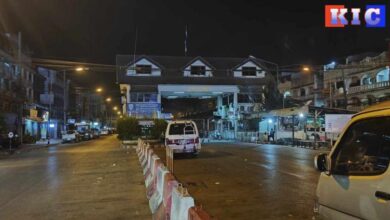Border closure hurts traders

Since July 2010, Burma’s military regime has insisted on keeping the Myawaddy-Mae Sot border checkpoint closed in retaliation for what it claims was the unofficial construction of a concrete embankment on the Thai side.
A year has almost passed and the border crossing between Mae Sot and Myawaddy is still closed. In spite of rumours that it would open after Burma’s national elections in November 2011, the bridge is still closed. Burmese authorities have cranked up the pressure on traders by enacting a complete ban on all trade crossing between the two countries.
In March 2011, Myawaddy authorities tightened their stranglehold, by officially announcing the closure of all trade crossing the border – effectively banning the import of all goods from Thailand into Burma via Karen State.
According to traders from Burma the closure is financially crippling them. Mae Sot business house echo the Burmese business people’s concerns.
Myawaddy District Peace Council (DPC) chairman U Khin Maung Lwin and his officials held a meeting with traders in Myawaddy Town on the 8th of March confirmed the ban on border trade. A local trader told Karen News that transporting goods will take longer and be more expensive as the ‘new’ routes will be longer and more difficult as smugglers will have to find news ways to avoid checkpoints.
The trader explained.
“Authorities summoned us and told us not to import goods from Thailand until they lift the restrictions. They told us if we fail to heed the warning, our goods will be seized and confiscated. During the closure last year we had to import our goods through the Tadarkyoe crossing to avoid checkpoints. Now it is even more difficult, as we have to go through Tokawko – the roads there are not good, it has been raining and that causes us a lot of problems.”
A trader who attended the meeting said no timetable was given for when the ban would be lifted. Traders say they were told that the process of transferring power from the military to the new civilian government hadn’t been fully completed, traders would have to wait until new economic procedures had been put in place.
Traders who store their merchandise near the border trading gates were invited to the meeting, out of the 54 only 28 showed up to discuss the closure of the trade crossing with government officials, including U Khin Maung Lwin, Chairman of Myawaddy township, U Aung Soe Thein, head of the trading zone, the Division commander General Naing Win.
WHERE THERE’S A WILL…
Adding to the confusion of border traders is the on-going conflict involving factions of the Democratic Karen Buddhist Army, Border Guard Force troops and Burma army soldiers. During the last 17 months, the Burma army has attempted to disarm and dismantle ethnic ceasefire groups under its control. The regime’s intention was to reduce their size and reform the groups as a Border Guard Force and bring them under the strict command of the army.
The Burma army’s attempts to reorganize the DKBA backfired and resulted in 1,200 soldiers, under the leadership of their Brigade commander, major general Saw Lah Pwe (aka Na Khan Mway), vowing to fight to the death their former sponsors – the military regime. The closure of the lucrative checkpoints increased the border tensions between the warring factions.
A BGF official said the initial closure of the Thai-Burma Friendship Bridge in July 2010 offered the BGF and opportunity to gain extra revenue via the numerous ‘unofficial tax gates’ along the border. Myawaddy traders were ‘encouraged’ to import their goods from Thailand through a newly established Border Guard Force ‘safe checkpoint or tax gate’.
“Despite the closure traders will find their own way of getting their goods inside Burma, they always do. At present, the authorities have been checking border trade every two or three days, but going through the established gates is more restricted and difficult.”
Myawaddy is one of the largest crossing points for border trade between Burma and Thailand – traders come from faraway as Rangoon, Moulmein, Pegu, Pa An, Kawkreik and Mandalay.
Prasert Juengkijrungroj, the secretary general of the Tak Chamber of Commerce in Mae Sot said in the Thai media that the three main items exported through Mae Sot to Burma are petrol, cooking gas and cooking oil.
Followed by second hand cars, electronic goods and MSG (monosodium glutamate).
“In 2009 exports through Mae Sot to Burma were worth 25 billion baht. This is a considerable increase from the five billion baht we earned in 2005. In 2010, before the [border] closure we estimated our exports would earn us more than 30 billion baht.”
Mae Sot traders say they are also feeling the economic effect of the border closure. Speaking to Karen News an electrical goods retailer said.
“I am now relying on selling phone cards. If I didn’t own the premises I would have shut down months ago.”
Myawaddy traders say local residents also fear a fresh outbreak of fighting between the Burma army and the DKBA faction that rejected the military regime’s border guard force.
A trader said.
“We’ve heard that the DKBA still plan to attack Myawaddy. Working as a trader has become more difficult and on top of that we now have the added security concerns. Many traders have left. Myawaddy is dead – there are only few traders left who are determined to keep working.”




